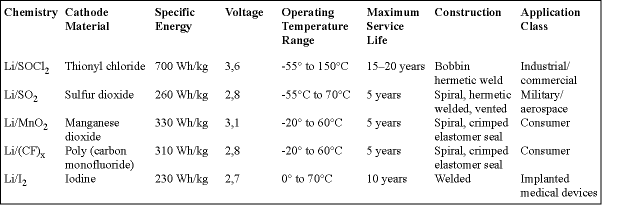
A key issue in battery design is the service life, which may be a critical parameter when specifying a battery.
Determining the right power management solution for any battery-driven application is a critical decision. The choice of battery system affects everything from the size and shape of a device, to its ability to withstand extreme temperatures and environments, to the life expectancy of the product and/or battery.
The 'power budget'
Choosing the right battery starts with an in-depth understanding of your product's specific electrical requirements and potential use. You must understand the basic requirements for the following:
* Minimum, maximum, and nominal operating voltage.
* Power or current requirements.
* Continuous background current (if any).
* Pulse current amplitude and duration.
* Repetition rate if pulses are evenly dispersed, if not minimum, maximum, and nominal time between pulses.
* Storage and operating temperatures (minimum, maximum, and nominal).
* Available space allowed.
* Minimum battery lifetime desired.
Based on this initial information, the designer can work with a battery manufacturer to develop a 'power budget' - a mathematical formula that estimates battery life based on amperes-per-hour or watts-per-hour requirements over a given time and temperature. If the power budget indicates a battery life span of one month or less, rechargeable batteries may be ideal.
If the power budget indicates a battery life span from a few months up to one year, alkaline batteries may be the better answer. For longer-term applications, the design engineer will typically choose among primary lithium battery chemistries such as lithium manganese dioxide (Li/MnO2), lithium sulfur dioxide (Li/SO2), and lithium thionyl chloride (Li/SOCl2) (see Table 1).

Factoring in life expectancy
The formula for determining actual battery life expectancy is reasonably complex, requiring proprietary data that factor in a number of variables to determine the required capacity to deliver an expected run time. In addition to variables such as voltage, background current, and pulse profiles, the formula also factors in how the required temperature range will affect both the battery voltage, and, most important, the self-discharge rate of the battery.
Temperature has a significant impact on battery performance and life expectancy. If the application is designed for cold temperatures (below -20°C), such requirements can prove problematic for certain battery chemistries, since a cold electrolyte becomes less active, leading to higher internal resistance, which may lead to battery failure. When subjected to extremely high temperatures (above +40°C), certain battery chemistries and mechanical sealing techniques start to fail, affecting both short-term performance and long-term reliability.
Self-discharge: a key variable
The self-discharge rate of a cell is governed by its electrolyte composition, its production processes, and its construction. As a general rule, the greater the cell's internal surface area, the greater the self-discharge rate. In addition, high-rate spiral cells with large surface areas have inherently higher self-discharge rates compared to bobbin-type cells of equal size that use the same chemistry.
A lesser-known fact that impacts battery self-discharge involves impurity levels in the electrolyte. Through years of study and fine-tuning the electrolyte production processes, experienced battery manufacturers have found ways to lower battery self-discharge rates by reducing electrolyte impurities and parasitic reactions to nominal levels.
Impedance
Battery life is also affected by impedance. Unfortunately, battery impedance is not a nice stable number, but rather one that varies by time, temperature, and the mechanical environment it must operate within. Impedance is measured by the internal resistance developed not only in the electrolyte, but also in the cathode and anode. Impedance can also rise as a result of electrolyte loss, as might occur in a consumer Li/MNO2 coin cell. Even though the coin cell's seal remains intact, being in an elevated temperature environment can cause the electrolyte to simply diffuse through the seal. With less liquid available, the impedance rises. Other battery chemistries can be affected by certain types of pulses that can clog the cathode with by-products of the reaction, causing a rise in impedance, measurable through a reduction in load voltage.
Different chemistries have different theoretical impedances. As noted, impedance can change with temperature, discharge time, and vibration. However, by blending special additives with the electrolyte, impedance levels can be controlled by the battery manufacturer.
Real-life considerations
In determining the ideal power solution, the design engineer must factor in a number of real life as well as theoretical considerations. How the product will be used is often as important a factor as the product's design:
* Operating environment. As discussed, extreme cold and heat can cause failure or limit the performance of some battery chemistries. Also, how will elevated temperatures affect battery lifetimes and performance?
* Battery safety. Does the application involve high levels of shock and vibration? What are the potential consequences if the battery leaks if crushed or punctured? Does the battery need to be UL listed?
* Size and weight. Are there practical limits as to how small and lightweight the device must be? When size and weight constraints are important, you must typically opt for the battery with the highest energy density to pack the most performance into the smallest space with the least weight.
* Voltage requirements. Battery voltage is inherent to the type of chemistry. However, load voltage can be affected by the battery's impedance, which some battery manufacturers manipulate with electrolyte additives and capacitors. For example, Tadiran offers battery packs with integrated hybrid layer capacitors to deliver a complete solution.
For more information contact Quintin van den Berg, Arrow Altech Distribution, 011 923 9600, [email protected]
| Tel: | +27 11 923 9600 |
| Email: | [email protected] |
| www: | www.altronarrow.com |
| Articles: | More information and articles about Altron Arrow |

© Technews Publishing (Pty) Ltd | All Rights Reserved